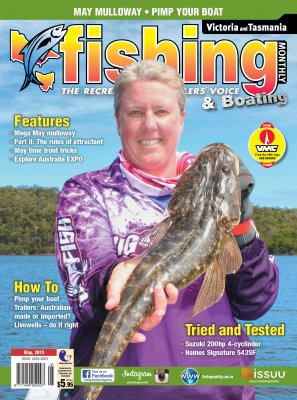May time trout tricks by Robbie Alexander
 Like so many fish species across the region, trout can be very hit and miss during May. This is typical of trout fishing late in autumn anywhere in the world as they lead up to their annual spawning run.
Like so many fish species across the region, trout can be very hit and miss during May. This is typical of trout fishing late in autumn anywhere in the world as they lead up to their annual spawning run.
When I say lead up to their spawning run, in some of the smaller cooler waterways the brown trout will often start spawning in May. For a long time I have wanted to see the Victorian trout season close at least a fortnight earlier than it currently does, but unfortunately this does not look likely to happen.
The problem is that the brown trout usually spawn from around late May until late June, and occasionally into July. The rainbow trout spawn much later. They don't start spawning until around mid July and can go right through until mid September. The only way to have a closed season that would offer full protection to both species would be to close the trout season at the start of May and re-open it at the start of October, leaving a total closed season of 5 months.
This would be great for the trout and the trout numbers, however it would be quite detrimental to the areas where trout fishing is such a draw card for communities who rely on anglers to pour money into their towns. Not to mention having a 5 month closed trout season would be nothing short of painful! So, as it is the current closed season offers protection to both species in part, while they spawn.
WHAT CAN WE EXPECT?
Apart from lots of autumn colour in the sub alpine towns where the trout are usually found, we can expect some hot and cold trout fishing, low water levels, icy cold starts and cool days.
Each year during autumn, usually during April, the shorter days and cooler water usually trigger the trout to start swimming upstream to spawn. Trout are an annual spawner, meaning they will swim upstream regardless of conditions, provided there is enough water in the rivers and creeks for them to move about freely.
They leave their usual residence and swim upstream to spawn, where they will join trout of the opposite gender (called pairing up) and park themselves over an area of fine to medium gravel known as a redd. They can spend considerable time paired up over the redd, and at this time the male can become very aggressive towards other fish.
The redd is where the trout spawn. The female will use her pectoral fins and tail to dig a depression in the gravel. Then, when she is ready she will drop her eggs in that gravel. The male will then move over the eggs and fertilise them before the female returns to gently bury the eggs, usually by digging another hole in the gravel at the upstream side of the redd so that the newly dug gravel can gently settle on top of the now fertilised eggs.
The fertilised eggs will sit underneath that gravel (in the redd) for up to 6 weeks until they are ready to hatch. Once they hatch, the newborn fry will find their way out of the gravel. The fry will feed on the eggsack for a few days, during this time they will float freely downstream until they are strong enough to swim for themselves. This is the whole reason the trout swim upstream to spawn in the first place, to allow for the fry to float back down once they have hatched.
NOW TO THE FISHING
I will fish during May until such a time that I notice evidence of trout spawning. It is quite obvious to see when trout have spawned over a redd, as the areas of medium sized gravel appear to have been disturbed. Usually there are mounds and depressions in the gravel areas where the trout have spawned.
Early in May the trout are often still on the move upstream. This can be a fantastic time of the year to fish for trout as the larger trout swim upstream from their usual hard to get to places in remote stretches of waterways and into the easy to get to spots.
In spring and summer, the adventurist angler has a clear advantage when they walk for kilometres, climb down rocky outcrops and tackle blackberries head on to get to the more remote areas. In May, the trout leave these remote areas to swim upstream to spawn and are often caught in areas of high fishing pressure as they pass through. So if you have fished a certain stretch of water during the trout season and had no luck, don't write it off as it could well become productive during May.
Another thing to remember is that trout can not climb walls and waterfalls, so barriers that prevent trout from swimming further upstream can be real hotspots during May. Spillways, small waterfalls, and other artificial obstacles can prevent trout from swimming upstream to spawn, so these areas can really turn it on during May as the trout have a tendency to bank up on the downstream side of them.